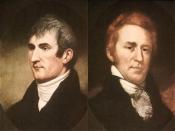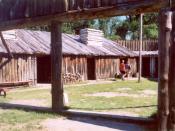The Louisiana Purchase
In 1803, the United States was just 20 years old. There were 17 states in the Union and the American territory reached only as far West as the Mississippi River.
On the other side of the Mississippi between the river and the Rocky Mountains, was the unexplored Louisiana Territory. In 1800 Napoleon, emperor of France had taken Louisiana back from Spain who ruled it since 1763.
President Jefferson did not want the French army threatening America's western boarder. He wasn't ready to risk the closing of the port of New Orleans at the mouth of the Mississippi, a vital to American trade. In March 1803, Jefferson instructed his minister to France, Robert R. Livingston, to buy New Orleans from Napoleon. At that time Napoleon was not wanting to fight Great Britain and being in too many places at once offered to sell the whole of the Louisiana Territory for about 60 million Frances- 15 million dollars.
The Expedition
President Jefferson thought this land should be explored before the United States took possession of the territory. President Jefferson was interested in knowing more about the country west of the Mississippi. In 1803, two years after he became president, he asked Congress for $2,500 for an expedition. Late in 1803 into early 1804, The President had been discussing an expedition of the Pacific Ocean. - On June 20, 1803, President Jefferson asked his young secretary Captain Merewether Lewis, to lead an expedition from the Mississippi River to the West Coast.
Lewis agreed. As co-leader he chose Lieutenant William Clark who had once been his commanding officer during the war. Both were familiar with the frontier and with Indians through their service in the army.
Before Lewis and Clark set out, word came that Napoleon had sold an immense tract...


